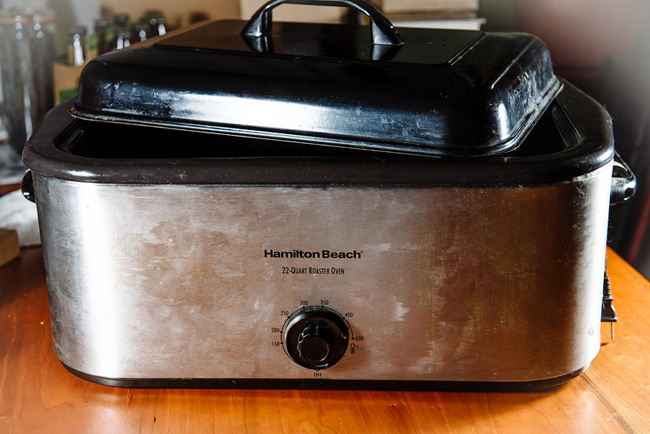
Several million stories have been written about how to season, brine, and / or roast a turkey, so we won’t attempt to grapple with those issues here. Instead, we will make two simple and sensible recommendations that — if heeded — will likely result in a brilliant and happy Thanksgiving for all involved.
The first is to cook your turkey in a tabletop electric oven. We like the Hamilton Beach 22-quart roaster (pictured above) or the Nesco 18-quart roaster (it also comes in camo, if you happen to be under enemy fire while preparing your meal). Retailing at $40-$70 (Fleet Farm always carries a variety of sizes), these marvelous devices can handle up to 22-pound birds.
Using an electric oven accomplishes a few things. First and foremost, it frees up your regular old oven for the endless parade of sides and other dishes rotating through the kitchen on Thanksgiving. Second, it cooks turkeys quickly. We’ve been able to finish 22-pound birds in under three hours, faster than we’ve managed in our conventional oven, and so fast that we start temping the bird at around 90 minutes because the last 20 or 30 degrees in temperature change come fast and furiously. Finally, if you put the electric oven somewhere accessible to your guests, the basting and checking of the turkey becomes Thanksgiving theater, a chance for everyone present to ooh and aah and enjoy the way the cooking bird fills the room with plumes of savory delight.
Our second recommendation is this: brine your turkey. But don’t soak your turkey in salt water — rub the salt onto the skin. It works beautifully to tenderize the meat and spares you the effort of filling and then disposing of gallon after gallon of turkey water. We’ve tried both ways, and now swear by the dry-brine method. The New York Times breaks it down quite nicely in their essential guide to Thanksgiving.

I am late on this, but for next year: I would like to point out that these tabletop “roasters” are an insult to turkeys everywhere. Basically, it’s not a roaster–it’s a slowcooker, and it’s not large enough to allow air to circulate around a good-sized turkey. In effect, you’re steaming your bird, rendering it mushy and flavorless. You also lose two of the major attractions of turkey. First, the skin of a slow-cooked turkey is not browned and crispy; it is pale and soft and a bit gross. Second, no pan=no pan gravy. You can work up an imitation with stock, yes, but it’s not the same.
I have the misfortune of being served a turkey out of one these atrocities every year, since my well-meaning and otherwise wonderful mother discovered the “ease” of this method. None of us can bear to tell her how much it sucks, so instead we slather our dry, spongy meat in fake gravy and wish the thing would break.
Please, do not promote such misery to others.